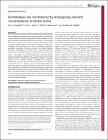| dc.contributor.author | STOUT, JANE | en |
| dc.date.accessioned | 2016-01-08T14:41:12Z | |
| dc.date.available | 2016-01-08T14:41:12Z | |
| dc.date.issued | 2014 | en |
| dc.date.submitted | 2014 | en |
| dc.identifier.citation | Tiedeken EJ, Stout JC, Stevenson PC, Wright GA, Bumblebees are not deterred by ecologically relevant concentrations of nectar toxins., The Journal of experimental biology, 217, Pt 9, 2014, 1620-5 | en |
| dc.identifier.issn | 0022-0949 | en |
| dc.identifier.other | Y | en |
| dc.identifier.uri | http://hdl.handle.net/2262/75529 | |
| dc.description | PUBLISHED | en |
| dc.description.abstract | Bees visit flowers to collect nectar and pollen that contain nutrients and simultaneously facilitate plant sexual reproduction. Paradoxically, nectar produced to attract pollinators often contains deterrent or toxic plant compounds associated with herbivore defence. The functional significance of these nectar toxins is not fully understood, but they may have a negative impact on pollinator behaviour and health, and, ultimately, plant pollination. This study investigates whether a generalist bumblebee, Bombus terrestris, can detect naturally occurring concentrations of nectar toxins. Using paired-choice experiments, we identified deterrence thresholds for five compounds found in the nectar of bee-pollinated plants: quinine, caffeine, nicotine, amygdalin and grayanotoxin. The deterrence threshold was determined when bumblebees significantly preferred a sucrose solution over a sucrose solution containing the compound. Bumblebees had the lowest deterrence threshold for the alkaloid quinine (0.01 mmol l(-1)); all other compounds had higher deterrence thresholds, above the natural concentration range in floral nectar. Our data, combined with previous work using honeybees, suggest that generalist bee species have poor acuity for the detection of nectar toxins. The fact that bees do not avoid nectar-relevant concentrations of these compounds likely indicates that it is difficult for them to learn to associate floral traits with the presence of toxins, thus maintaining this trait in plant populations. | en |
| dc.format.extent | 1620-5 | en |
| dc.relation.ispartofseries | The Journal of experimental biology | en |
| dc.relation.ispartofseries | 217 | en |
| dc.relation.ispartofseries | Pt 9 | en |
| dc.rights | Y | en |
| dc.subject | Bombus terrestris | en |
| dc.title | Bumblebees are not deterred by ecologically relevant concentrations of nectar toxins. | en |
| dc.type | Journal Article | en |
| dc.type.supercollection | scholarly_publications | en |
| dc.type.supercollection | refereed_publications | en |
| dc.identifier.peoplefinderurl | http://people.tcd.ie/stoutj | en |
| dc.identifier.rssinternalid | 109668 | en |
| dc.identifier.doi | http://dx.doi.org/10.1242/jeb.097543 | en |
| dc.rights.ecaccessrights | openAccess | |
| dc.identifier.orcid_id | 0000-0002-2027-0863 | en |




